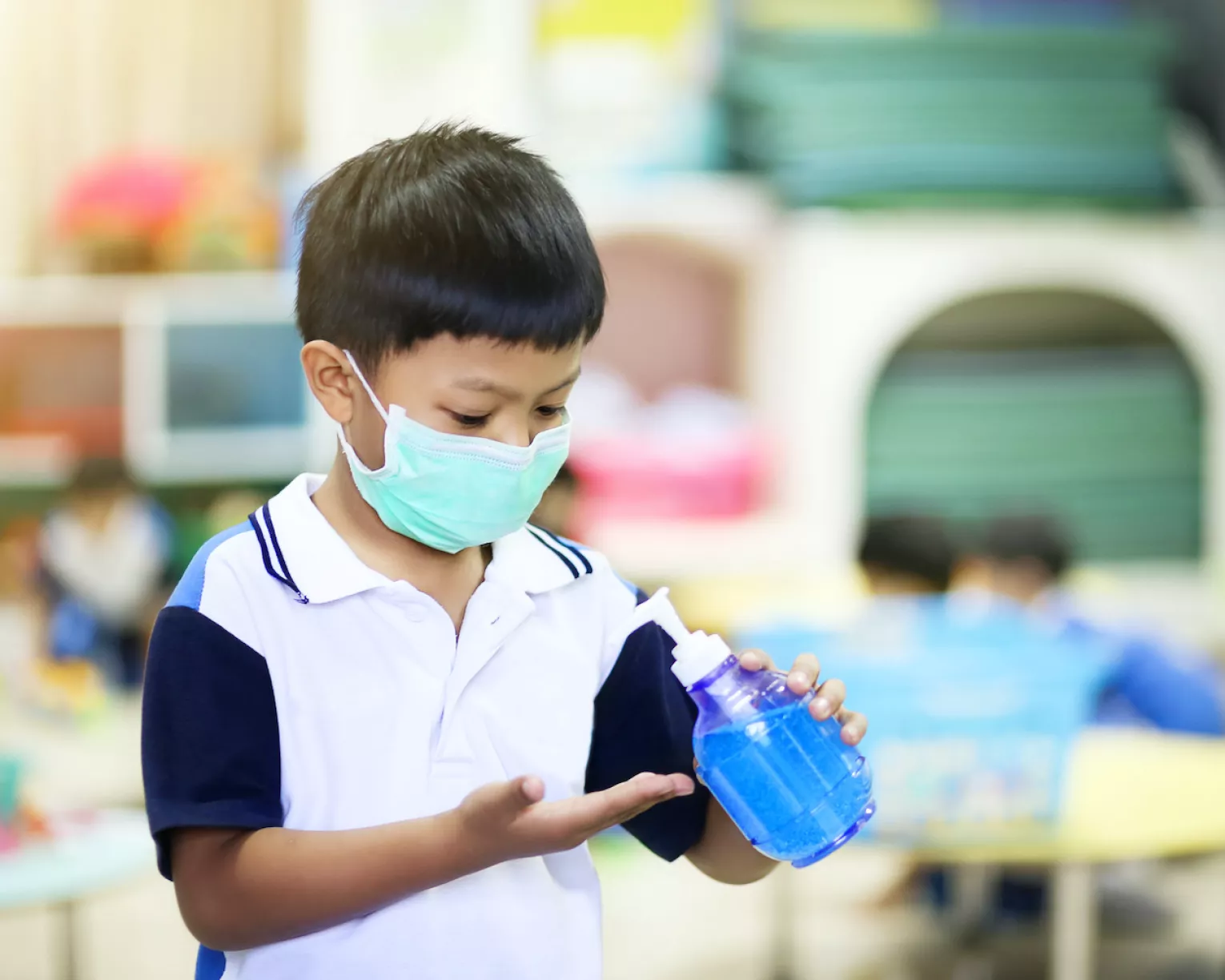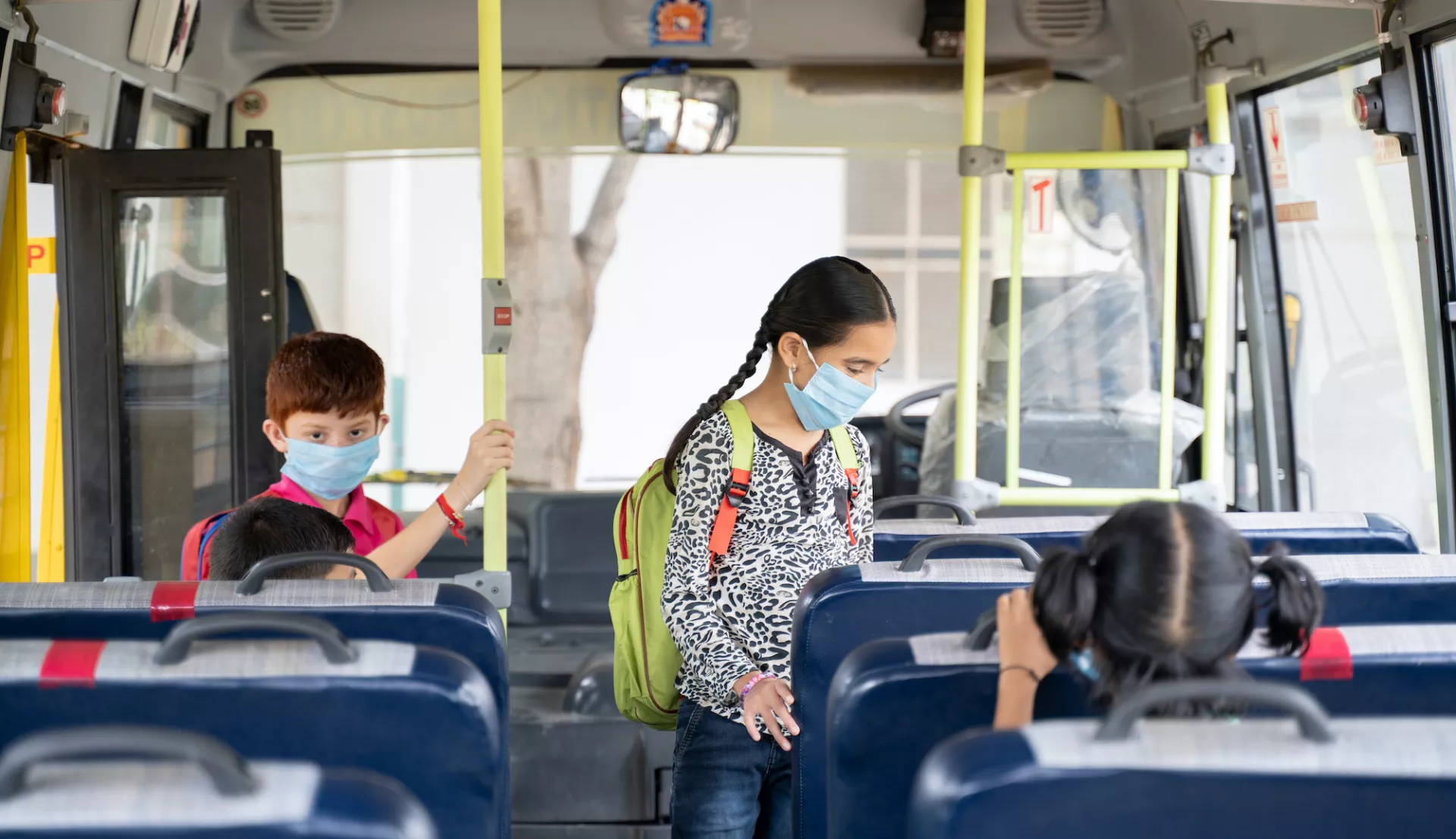Overview
Schools have always been community centers—for education of course, but increasingly for nutrition, health, early and after care, communication, and so much more. While these hubs provide critical supports for communities, they are also designed around bus routes. Most schools are inaccessible without motorized transportation due to their building’s distance from residential neighborhoods and unsafe pedestrian conditions. When considering the logistics of school reopening during COVID-19, school districts must make it a priority to plan for the safe transportation of students.
Assessing Need
It is imperative that districts learn the scope of their transportation challenges. To do this, districts should survey families to assess their intention regarding the return of their children to school and their transportation needs. Although this guidance addresses only school-provided bus transportation, it should be noted that there may be separate, additional concerns about potential exposure to COVID-19 for districts where students rely primarily on public transportation.
Physical Distancing

The ability to put at least six feet of distance between people is one of the most effective ways to slow the spread of COVID-19. The CDC considers close contact with a COVID-19 infected person to be within six feet for a cumulative period of 15 minutes over a 24-hour period, indicating the need for contact tracing. These guidelines are meant to reflect that the disease is extremely contagious and should not be taken as absolute. For example, staying seven feet away from an infected person for 14 minutes, does not necessarily keep one safe from contagion.
Safe distancing on school buses means one masked child per seat bench at staggered intervals (see diagram). These seating arrangements would result in buses operating a route at about one-third of capacity. Schools must be innovative and flexible as it relates to scheduling in-school time, taking into consideration whether a district is able to run multiple bus routes. This could mean staggered start times, or alternating attendance days for students.
It should be noted that school districts that privatize their transportation systems will face even greater logistical challenges. In these cases, districts will have to negotiate with private carriers whose priorities are not exclusively the health and safety of students and employees.
Making Student, Staff, and Community Health a Priority
- When possible, encourage families to provide their own transportation to reduce overall transportation capacity challenges
- Note: This could create equity issues for families without access to a private vehicle or those who face other obstacles in transporting their children to school.
- Plan around the major issue of low bus capacity due to physical distancing measures.
Questions to Ask:- Can your district afford to run multiple bus routes with buses at 1/3 capacity?
- Will this situation be compounded by a shortage of drivers, which was an issue pre-COVID-19, and is sure to be more acute now?
- If you use a contractor, will that contractor accommodate multiple daily runs?
- Will a contractor follow all the new protocols?
- If so, at what additional costs?
- Do multiple bus runs work for rural areas?
- Explore ways schools could be made more accessible for pedestrians and cyclists
- Consider that schools may be operating food and materials distribution programs for students not attending in-person, while at the same time running in-person operations. This could impact bus drop off and pick up.
- Make accommodations for potential increases in vehicle traffic and pedestrians, on and near school property.
Questions to Ask:- Will additional staff be needed in the parking lot?
- What about streets and intersections near the school?
- Secure an adequate supply of PPE to help ensure the health and safety of students, drivers, and monitors. PPE for staff must account for multiple bus runs and cleaning between runs. Also, drivers and monitors should be given options between N-95 face masks, face shields, or both. Drivers will need to experiment with PPE options that do not interfere with visibility.
- Keep in mind that safety begins at the bus stop. Ideally, a staff person such as a bus monitor would be assigned to supervise bus stops, at least until the procedures become routine for the students. Additionally, some bus stops are simply too populated, creating a challenge for physical distancing; consider pick-up locations and/or staggered start times.
Questions to Ask:- What masking and physical distancing measures can be implemented there?
- Who will supervise?
- Before students return to school, provide parents with detailed instructions for helping their children with the new procedures. Additionally, instruct parents on home screening their children for COVID symptoms before sending them to the bus stop.
- Remember that staff, who are key to the transportation operation such as drivers, monitors, and bus barn employees, must have the freedom and confidence to report safety violations. In collective bargaining states, this may necessitate a Memorandum of Agreement guaranteeing job security for employees who report violations. In states without collective bargaining, these rights could be clarified in a Memorandum of Understanding with the majority union, association, or organization. Absent either of these possibilities, school board policy should be changed to incorporate whistleblower protections for transportation employees.
The Bus Ride
- Drivers and monitors should be masked, and have the option of also having face shields, neither of which should obstruct the driver’s vision.
- Students should board the bus wearing a face mask positioned over the mouth and nose, while maintaining physical distancing.
- Students should be issued a face mask upon boarding if they do not have one.
- Age-appropriate students should be asked to use hand sanitizer upon boarding, unless they are wearing gloves.
- Students should be directed to marked seats, one child per bench.
- Students should wear masks and stay in their seat for the duration of the bus ride.
- To minimize proximate interactions for the bus ride, students who are first to exit the bus should be the last to board, and they should do so while maintaining physical distancing.
- Instructions for all of the above must take into consideration students who are English language learners, and students with special needs.
- Ideally, all of the above should be supervised by an adult staff person, other than the driver, such as a “bus attendant”, “bus paraeducator”, or “bus monitor.”
The Bus and Bus Operation
- The bus should be cleaned and sanitized before and after each route is driven. Cleaning solutions should be compliant with the EPA List N.
- Buses should be left with doors and windows open after cleaning to dry and “air out.”
- Masking and physical distancing should be practiced in the bus barn among staff and during all procedures.
- A hand sanitizing station should be installed at the front of buses for use of students when age appropriate.
- Appropriate signage for safety instructions should be posted on the bus. Consider multiple languages if applicable to the student population.
- Windows and roof hatches should be open while operating the bus (weather permitting).
- Buses with modern HVAC systems should use protocol developed by the Amalgamated Transit Union working with the Virginia Tech Transportation Institute and University of Washington Aerodynamics Department. ATU Bus Airflow
“OPERATOR should use these AIR CONTROL SETTINGS to create safer airflow in their vehicles. Also, where temporary barriers have been installed, these settings will INCREASE effectiveness. 1. Driver’s window CLOSED 2. Driver’s air and front vents set to FRESH 3. Blowers on FULL POWER in Front (wear earplugs) 4. Passenger windows CLOSED 5. Front roof hatch CLOSED 6. Blowers OFF in back 7. Rear roof hatch OPEN at its back 8. REAR DOOR Boarding”
(Please note, regarding number 8, with the exception of special needs transports, school buses do not allow for rear door boarding.)
Transportation for Students with Special Needs
- Some students with special needs may have compromised immune systems, which increases the need for physical distancing during transportation.
- Consider equipment, such as wheelchairs, in the logistics of physical distancing.
- An IEP may determine if/how some students are to be transported.
- The Individuals with Disabilities Education Act (IDEA) allows for parents to be reimbursed for transporting a child if the district chooses to encourage parents to do so.
- The use of bus monitors or paraeducators becomes more important in situations where students may have difficulty understanding or complying with COVID-19 safety such as keeping face masks in place or maintaining physical distancing.
- If the logistics for safely transporting students with special needs requires additional routes, this could involve drivers who have not had experience with this population of students. Districts will need to provide all drivers and monitors with adequate professional development for working with students with special needs.
Enforcement Considerations
School districts will need to consider the possibility of students, staff, and parents not complying with safety rules. Administrators and the school board should have stakeholder inclusive discussions on enforcement protocols in advance of implementing their transportation plans. Stakeholders should include union/association representatives for employees, as well as parents. The working group of stakeholders should be representative of the community in race, gender, sexual orientation, socioeconomics, etc.
Questions to Ask:
- If a driver, monitor, or other transportation official cannot get a student, parent, or staff member to comply with a safety order, who is contacted for enforcement? Does the bus continue to operate at that point, or is transportation stopped until an appropriate enforcement person arrives?
- What enforcement personnel do districts wish to consider: Administrators, school counselors, school security, school resource officers (SRO), or community police?
- Will school board policy be changed to accommodate the possibility of safety violations? For example, are suspension or expulsion possible consequences?
- Will the resulting policy or enforcement have an adverse effect on racial equity?
All of the above questions and considerations regarding enforcement should be resolved before the first bus rolls. It is not fair or safe to put drivers and monitors in the position of arbitrating these issues.
Are you an affiliate?



